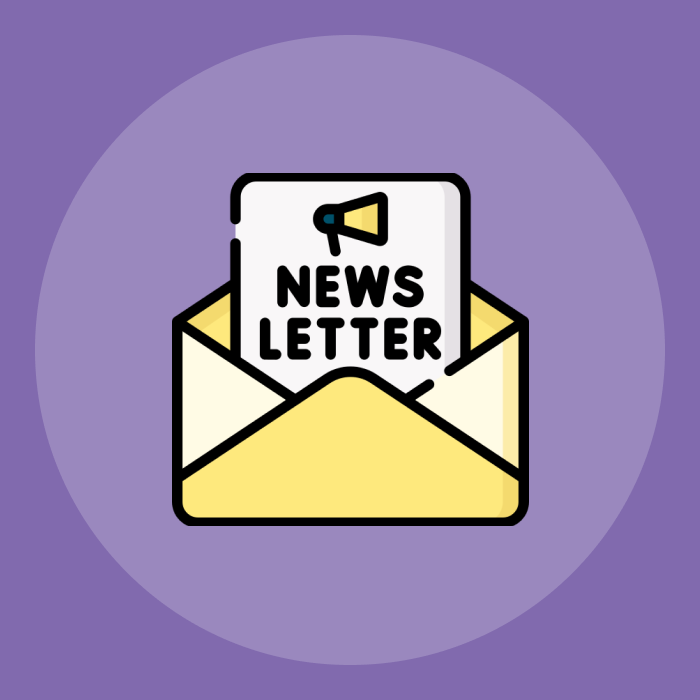Planning to send a curated newsletter to your recipients? This article tells you how to do it in nine easy steps and showcases the benefits you will get from it.
Did you know that 61% of people prefer to be contacted by their preferred brands via email? No wonder leading businesses strive to grow their email lists and use the communication channel to reach their audience.
However, just growing your email list isn't enough. You have to keep your recipients engaged by sharing relevant educational content. This is where email newsletters may come in handy. Email newsletters have served as an effective way for brands to generate awareness and convey their messages.
It's an excellent way to generate brand recall and keep your target audience up-to-date with the latest news or relevant updates. However, creating eye-catching newsletters day in and day out is not as easy as it sounds.
It may require you to increase your content output, which may, in turn, affect the quality of the content you produce. This is where curated newsletters come in.
They allow you to share relevant news and updates with your recipients by leveraging multiple external sources of information, leaving your content workflows unaffected.
Here's how you can create a curated newsletter for your recipients:
1. What is a curated newsletter?
Before we dive into creating a curated newsletter that helps you engage your audience and facilitates conversions, let's explore the concept first. Unlike standard newsletters that generally focus on your take on a topic or update, a curated newsletter is a compilation of relevant information from diverse external sources you share with your recipients.
Curated newsletters allow your readers to access all relevant news and industry updates from one place without exploring multiple information sources. It's an easy-to-digest content format for readers and allows brands to keep their audience engaged without much effort.
Standard newsletters generally encompass content you create and publish on your website for educational purposes, such as articles, blogs, infographics, or social media posts.
For your newsletter feature, you generally pick your best content piece with excellent educational material and the highest potential for engaging the intended audience. The goal here is to keep your audience up-to-date with relevant insights from your respective industry.
On the other hand, for curated newsletters, you don't have to rely on your content alone to keep your audience educated. You can leverage multiple information sources from your respective industry to engage your target audience.
This serves two purposes. First, you can share helpful industry insights with your audience and keep them hooked without taking your content workflows into overdrive. Second, your audience gets access to the information they seek without having to explore multiple sources.
This is a great way to get more eyeballs and make your audience rely on you for their daily dose of content.
2. The benefits of sending curated newsletters
Sending curated newsletters has a variety of benefits. The following are a few of them worth mentioning:
Seamless Content Workflows
Sending newsletters frequently to engage your audience may significantly impact your content creation workflows. To come up with fresh and eye-catching feature posts day in and day out, you have to churn out more content, which may end up affecting its quality.
On the other hand, curated newsletters leave your content workflows unaffected. Since you're sharing information from external sources, you are least concerned about the quantity of the content you produce and stay focused on maintaining its quality.
Saving Time
Did you know that over 4,000 blog posts are published per minute worldwide? Information on the internet is abundant, as you can access answers to your questions with just the click of a button. However, finding them amidst the digital noise can be pretty challenging.
This is where curated newsletters come in handy, as they bring access to trending stories and relevant industry updates to your audience's fingertips. When it comes to sharing relevant content with your audience, curated newsletters save time for you.
Plus, they make it easier for your audience to access information per their preferences.
Greater Traction
As said earlier, sending curated newsletters makes accessing relevant information easier for your audience. You do all the heavy lifting and help your target audience find the information they seek. This may help you earn their respect and generate more traction for your brand.
You become the go-to source for your audience, giving them access to the latest industry news and updates, making it possible for you to get more eyeballs.
Brand Awareness
Sending curated newsletters helps you increase brand awareness. It's a great way to cast a wider net and instantly convey your message to the masses. By sending curated newsletters, you reach out to your audience and encourage them to learn more about you and the solutions you offer.
Newsletters generally contain links to your website and social media pages, which may increase your visitors and enable you to grow your followers. The more people know about your brand and what you offer, the higher your chances are of capturing quality leads and increasing your conversions.
Trust and Loyalty
Curated newsletters are an excellent strategy to keep your audience engaged by facilitating access to high-quality educational content. It enables you to cover the latest trends and feature valuable insights from thought leaders or the industry's experts all in one place, generating high value for your target audience.
By sharing relevant information, you enable your audience to find answers to their questions and make informed decisions, which in turn helps you foster trust and loyalty.
3. How to create a newsletter that converts?
Now that we've talked about curated newsletters and the benefits of sending them, here are the steps to creating one for your target audience:
1. Know Your Audience
In order to curate a newsletter that fosters engagement, it's essential to be familiar with the needs and preferences of your target audience. This helps you tailor your content to your recipients' interests and increases their chances of interacting with what you share.
As a result, you acknowledge higher engagement and keep people subscribed to your email list. So, you should be acquainted with the characteristics of your audience and know why you target them. Knowing your audience is critical for the curation process.
It dictates the way you come up with your message and the tone in which you convey it.
2. Segment Your Email List
We're assuming that you already have an email list. If you don't, you should prioritize having one first. Once you have a list of recipients agreeing to receive your messages, the next step is segmenting the list per different profiles.
People may have diverse preferences when it comes to consuming content. Since you're familiar with different things that may interest your audience, you should segment your email list accordingly and create different groups.
This means creating multiple email lists from the one you have, depending on your needs. Segmenting your email list lets you send messages catering to your audience's preferences.
The average open rate of a standard email campaign is less than 2%. Sending messages tailored to your audience's interests may help you boost it and acknowledge high engagement.
3. Find Relevant Topics
Once you've segmented your email list, the next step is finding relevant content curation topics. The best way to do that is by looking at your direct competitors and taking inspiration from the content they've been sharing with their audience.
Plus, you must monitor your industry's current trends to identify low-hanging opportunities to curate content. Exploring queries related to your focus keywords is also a great idea and can give you helpful information for content planning.
If this isn't the first time you've planned to send a curated newsletter, you should consider leveraging the past data. Pick the curated newsletters that performed exceptionally well and try to explore similar topics.
Once you've gathered data from different sources, you can brainstorm and decide on relevant topics for the curated newsletter.
4. Find Trusted Information Sources
Once you have finalized suitable topics, the next step is finding trusted sources of information for the content. When you curate content, you rely on external sources for the information you share with your audience.
So, the goal here is to identify the thought leaders in your industry who produce content around the topics you've selected for curation.
5. Find Content that Generates Value
Once you have identified the trusted sources of information in your industry, the next step is finding helpful content to fuel the curation process. You have to look for content that has the potential to drive high engagement and keep your readers coming back for more.
When curating content for your audience, you should ideally spend 95% of your time finding and reviewing content that generates value and the rest on sharing it with your target audience.
6. Validate the Information
Once you've found content that resonates with the needs and preferences of your audience, the next step is validating the collected information and ensuring its authenticity before sharing it. You must be thinking that if you have selected trusted information sources, why do you need to validate their shared content?
The answer to this is that content becomes obsolete with time. So, even if you've gathered the data from reliable sources, it's best to fact-check and see if the information you share with your audience is accurate.
You can't take everything at face value, even if it's from thought leaders in your industry. So, you should always validate the information gathered before initiating the curation process.
7. Ask for Consent
Once you've validated the information collected, the next step is to reach out to the sources and ask for their consent. When you are curating content, getting consent from the originator of the information you're going to use is important.
Not only does it make the curation process ethical, but it also protects you from copyright or regulatory violations. Taking the content posted by someone and using it without their consent may lead to severe penalties.
It may also tarnish your brand's image and leave a wrong impression on your audience. So, before you start curating content, always reach out to the sources you've collected data from and ask them if they're okay with you leveraging their content and sharing it with your audience.
8. Start Curating
After you've obtained consent from your sources, now is the time to commence the curation process. Remember, you can't just take the content published by someone else and share it with your audience without adding something original from your end.
So, we highly recommend you consider adding value when leveraging third-party content. Think about it. It's your audience you'd be sharing the content with. So, they will be interested to know about your take on the matter compared to the sources you took information from.
Plus, you understand your audience better than anyone else. So, only you can tailor the curated content to meet the expectations of your recipients.
9. Choose the Right Time to Send Curated Newsletters
Once you've completed the curation process, you must determine the frequency of sending newsletters to your recipients. There is no sure-shot recipe for success here. The goals or results you want to achieve dictate the frequency of your newsletters.
So, it should be in harmony with your key performance indicators. Plus, you might have to consider moderation here, as flooding your recipients' mailboxes may do more harm than good. It's best to consider trial and error.
You can create multiple campaigns and test out different frequencies for your newsletters. By doing this, you will back your decisions with data and increase the likelihood of achieving the best results.
Final Words
There you have it: the nine steps to creating a curated newsletter that converts. If you've been on the fence about whether or not you should send curated newsletters to your audience and how to do it, this article may be a valuable resource for you.
Subscribe to weekly updates
You’ll also receive some of our best posts today




![App Store Optimization [ASO]: A Step-By-Step Guide for 2023](png/complete-step-by-step-guide-to-app-store-optimization-2018-aso.png)

